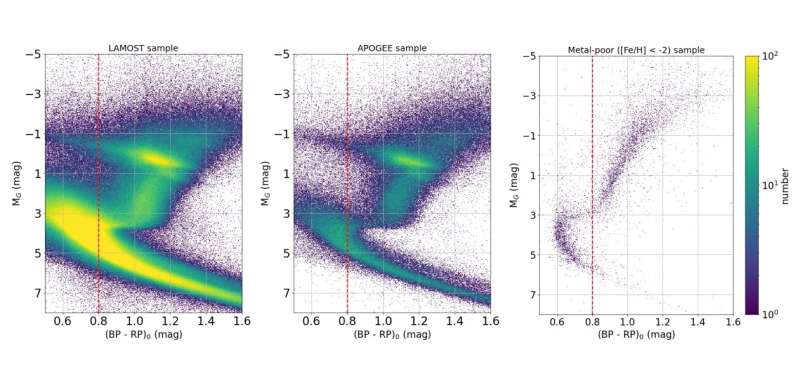April 11, 2023 report
This article has been reviewed according to Science X's editorial process and policies. Editors have highlighted the following attributes while ensuring the content's credibility:
fact-checked
preprint
trusted source
proofread
Astronomers detect nearly 200,000 candidate metal-poor stars

By analyzing the data from various astronomical surveys, astronomers have detected 188,002 candidate metal-poor stars. The discovery, reported in a research paper published March 30 on the arXiv pre-print server, may help us better understand how the universe chemically evolved.
Metal-poor stars are rare objects as only a few thousands of stars with iron abundances [Fe/H] below -2 have been discovered so far. Currently, SMSS J0313–6708, with metallicity below -7.3, is the most metal-poor star known to date.
Astronomers are interested in expanding the still short list of metal-poor stars as such objects have the potential to improve our knowledge of the chemical evolution of the universe. The early evolution of the universe is believed to be dependent on the properties of the first generation of metal-free stars.
Recently, low-resolution blue and red photometer spectra (BP/RP or XP spectra) for 210 million stars have been published with the Data Release 3 (DR3) from ESA's Gaia satellite. A team of astronomers led by Yupeng Yao of the University of Chicago decided to comb through this dataset, which provides an opportunity to greatly increase the number of candidate metal-poor stars. Their study was complemented by data from the Large Sky Area Multi-Object Fiber Spectroscopic Telescope (LAMOST) survey and from the Apache Point Observatory Galactic Evolution Experiment (APOGEE).
"In this work, we train XGBoost models to identify metal-poor stars in Gaia DR3. The input to the models are the coefficients of normalized and dereddened XP spectra. ... We utilize the coefficients of normalized and dereddened XP spectra together with their corresponding [Fe/H] from LAMOST or APOGEE to compose training and testing sets to train the XGBoost model to identify metal-poor stars in Gaia DR3," the researchers explained.
XGBoost is a powerful and flexible algorithm that has been utilized in a variety of sub-fields of astrophysics. By employing the XGBoost classification algorithm, the astronomers obtained three corresponding candidate metal-poor star catalogs.
All in all, the team managed to identify 127,096 bright and 60,906 faint candidate metal-poor stars in the Milky Way galaxy. The researchers noted that the total number of candidate metal-poor stars they obtained is around an order of magnitude larger than that from previous studies.
According to the paper, Galactic bulge and halo stars are the dominant objects in the whole sample. The astronomers estimate that about 84,200 stars out of the 188,002 identified candidates are expected to be genuine metal-poor stars, which represents an overall purity of 45%.
The authors of the study expect that about 600 stars of the assumed 84,200 genuine metal-poor stars are extremely metal-deficient, with metallicities below -3.5. They calculated that the other 2,800 stars should have metallicities between -3.5 and -3.0.
More information: Yupeng Yao et al, 188,000 Candidate Very Metal-poor Stars in Gaia DR3 XP Spectra, arXiv (2023). DOI: 10.48550/arxiv.2303.17676
Journal information: arXiv
© 2023 Science X Network




















